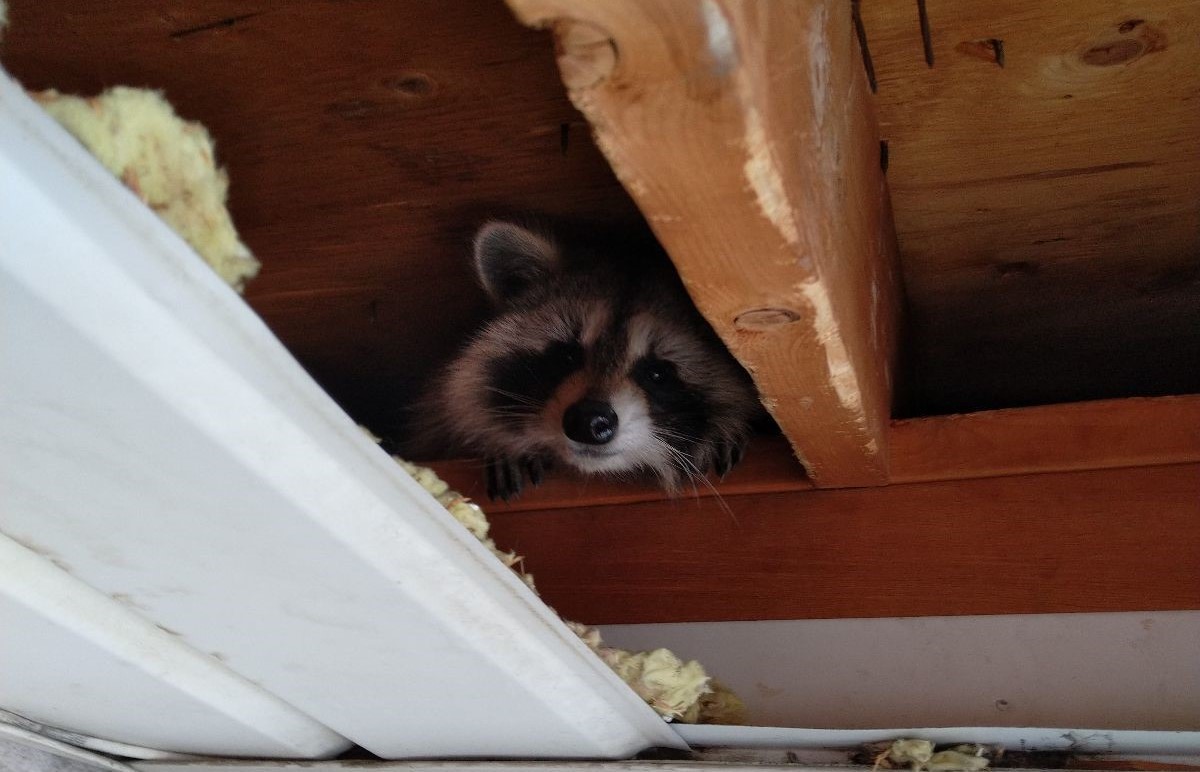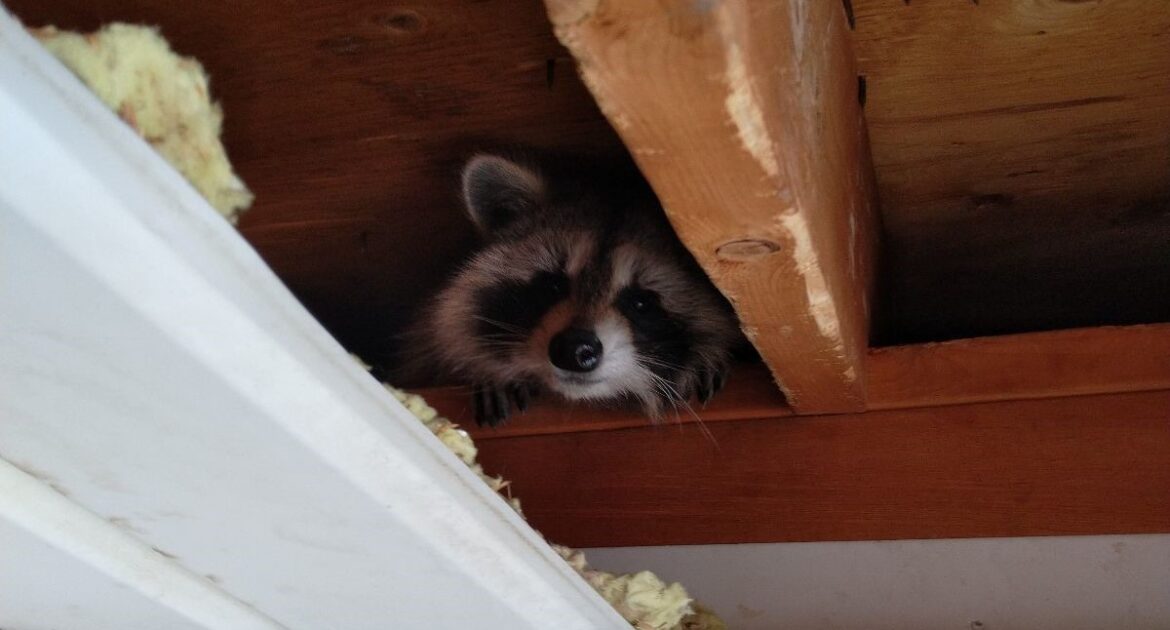You’re lying in bed at 2 am when you hear it again – thump, thump, scratch. Those mysterious noises on your roof are keeping you awake, and you can’t help wondering what’s causing them.
If you’re hearing heavy footsteps, scratching sounds, or chattering noises above your head, you might be dealing with raccoons on roof signs. These masked bandits are clever creatures that see your home as the perfect place to set up shop.
Could raccoons be trying to get inside from your roof? The short answer is yes. Raccoons are excellent climbers who often use roofs as highways to explore neighborhoods. When they find weak spots in your roof, soffits, or vents, they’ll take advantage of these entry points.
Understanding noises on roof raccoons and recognizing the early warning signs can help you take action before these unwanted guests cause serious damage to your home.
At Skedaddle Humane Wildlife Control in Vinings, we’ve helped countless homeowners deal with raccoon problems. Our experts know exactly what to listen for and how to keep these persistent animals from turning your attic into their new home.
Preventing raccoons from entering your house starts with knowing what signs to watch for and acting quickly when you spot them.
What Do Raccoons on Your Roof Actually Sound Like?
Raccoons aren’t quiet houseguests. These animals weigh between 10 to 30 pounds, so when they move around on your roof, you’ll definitely hear them. The sounds raccoons make are very different from smaller animals like squirrels or birds.
Here’s what you might hear:
- Heavy Thumping: Like someone walking around in boots
- Scratching Noises: Their claws scraping against shingles or metal
- Chattering or Chittering: Raccoons “talk” to each other
- Scurrying Sounds: Quick movements across the roof
- Banging: They might knock things over or drop objects
The timing of these noises matters too. Raccoons are most active at night, especially just after sunset and before sunrise. If you’re hearing these sounds during the day, it could mean a mother raccoon with babies has moved into your attic.
Unlike squirrels who make quick, light movements, raccoons create slower, heavier sounds. Their footsteps are more deliberate, and they often pause between movements. This is one of the clearest raccoons on roof signs you can identify without even seeing the animals.
Why Raccoons Love Your Roof
Your roof offers raccoons everything they’re looking for in a home. It’s high off the ground, which keeps them safe from predators. It’s also close to food sources like garbage cans, pet food, and bird feeders. Plus, roofs often have easy entry points into warm, dry spaces like attics.
Raccoons are smart problem-solvers. They can:
- Tear off loose shingles or tiles
- Pry open vent covers
- Squeeze through surprisingly small gaps
- Climb up downspouts and trees to reach your roof
- Remember good nesting spots and return year after year
Female raccoons especially love attics during spring when they’re ready to have babies. Your attic provides the perfect nursery – it’s quiet, warm, and protected from weather and predators.
Common Entry Points Raccoons Use
Understanding how raccoons get into homes helps you spot potential problems before they become major headaches. These clever animals don’t need big openings to find their way inside.
Roof Areas to Check:
- Damaged or loose shingles
- Gaps around chimneys
- Broken or missing vent covers
- Loose soffits or fascia boards
- Areas where different roof materials meet
- Damaged flashing around pipes or vents
Other Access Routes:
- Tree branches that hang over your roof
- Gutters and downspouts
- Satellite dishes or antenna mounts
- Roof edges near porches or decks
Raccoons have strong, nimble hands that work almost like human hands. They can grip, pull, and manipulate objects with surprising skill. This means they can open latches, remove covers, and create openings where none existed before.
Signs of Raccoon Damage on Your Roof
Once raccoons start exploring your roof, they often leave behind clear evidence of their visit. Knowing these raccoons on roof signs helps you act quickly before small problems become expensive repairs.
Physical Damage You Might See:
- Torn or damaged shingles
- Bent or broken vent covers
- Scratches or claw marks on metal surfaces
- Scattered debris from torn materials
- Damaged gutters or downspouts
Other Warning Signs:
- Raccoon droppings on the roof or in gutters
- Greasy smudge marks where they climb
- Strong odors coming from your attic
- Insulation or nesting materials visible from outside
The key is catching these signs early. A small hole can quickly become a big problem if raccoons decide your attic is the perfect place to raise their family.
Health and Safety Risks
Noises on roof raccoons aren’t just annoying – they can pose real health risks to your family. Raccoons carry diseases that can spread to humans and pets. They also cause property damage that can be expensive to repair.
Health Concerns Include:
- Rabies transmission
- Raccoon roundworm in their droppings
- Bacterial infections from contaminated areas
- Respiratory problems from disturbed insulation
Property Damage Risks:
- Destroyed insulation
- Chewed electrical wires (fire hazard)
- Water damage from roof holes
- Structural damage to wooden beams
- Contaminated living spaces
This is why it’s so important to call professionals instead of trying to handle the problem yourself. Raccoons can be aggressive when cornered, especially mothers protecting their babies.
How Skedaddle Prevents Raccoons From Entering Your Home
After we remove the raccoons, our team works to make sure they don’t come back. At Skedaddle, we focus on sealing up every entry point we find—whether it’s loose shingles, gaps in soffits, or broken vent covers. We use professional-grade materials designed to stand up to raccoon strength, so repairs last.
Our technicians also inspect your entire roof and attic for weak spots that raccoons might use in the future. We reinforce these areas and install protective barriers, like heavy-duty vent screens and chimney caps, to keep animals out. Because every home is different, we develop a custom plan for each property in Vinings.
With our experience and proven methods, you can trust us to handle preventing raccoons from entering your home, so you don’t have to worry about them getting back inside.
Why Professional Help Matters
Dealing with raccoons on roof signs requires expertise and the right equipment. These animals are stronger and smarter than most people realize. They can cause serious injuries if they feel threatened, and they often return to places where they’ve successfully nested before.
Professional wildlife control experts understand raccoon behavior. We know where they’re likely to enter, how they move through buildings, and the most effective ways to exclude them permanently. We also have the training and equipment to work safely on roofs and in attics.
Trying to solve raccoon problems yourself often makes the situation worse. Scared raccoons might retreat deeper into your home, create new entry points, or become aggressive. Professional removal ensures the job gets done safely and completely.
Trust Skedaddle for Raccoon-Free Living
Recognizing raccoons on roof signs early gives you the best chance of preventing serious damage to your home. Those noises on roof raccoons you’re hearing at night are trying to tell you something important – it’s time to take action.
At Skedaddle Humane Wildlife Control in Vinings, we specialize in preventing raccoons from entering homes and safely removing them when they do get inside. Our team uses proven methods that work for both homeowners and wildlife.
Don’t let raccoon problems keep you awake at night or put your family at risk. Contact Skedaddle today to request an estimate and learn how we can help you reclaim your home from these unwanted guests. Our experts are ready to assess your situation and provide a customized solution that keeps raccoons out for good.




